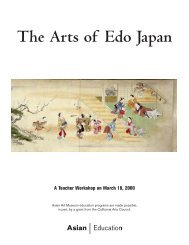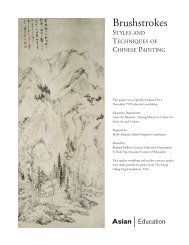Sacred Arts of Tibet (.pdf) - Asian Art Museum | Education
Sacred Arts of Tibet (.pdf) - Asian Art Museum | Education
Sacred Arts of Tibet (.pdf) - Asian Art Museum | Education
Create successful ePaper yourself
Turn your PDF publications into a flip-book with our unique Google optimized e-Paper software.
<strong>Sacred</strong> <strong><strong>Art</strong>s</strong> <strong>of</strong> <strong>Tibet</strong><br />
The Manchu Empire and <strong>Tibet</strong><br />
Manchu interaction with <strong>Tibet</strong> began in 1721, when the Manchu emperor <strong>of</strong> China’s Qing dynasty<br />
(1644-1911) sent a delegation to Lhasa. The Manchu Emperors were devout Buddhists who followed the<br />
<strong>Tibet</strong>an style <strong>of</strong> Buddhism exclusively. They looked to the Dalai Lama as their spiritual head, and invited<br />
large numbers <strong>of</strong> Lamas to establish monasteries and centers <strong>of</strong> <strong>Tibet</strong>an religion throughout China. Under<br />
the Manchus, <strong>Tibet</strong>an Buddhism became the state religion <strong>of</strong> China. (See Slides 9, 15, and 18)<br />
With the collapse <strong>of</strong> the Manchu Qing dynasty in China in 1911, <strong>Tibet</strong> lost its spiritual control over<br />
China. After the establishment <strong>of</strong> the People’s Republic <strong>of</strong> China in 1949, <strong>Tibet</strong> was subjected to increasing<br />
pressure from a new mechanized, materialistic China hungry for land and for the vast mineral treasures<br />
and forests <strong>of</strong> the <strong>Tibet</strong>an plateau. For the first time in history, the Chinese army had the means to<br />
successfully invade <strong>Tibet</strong>. With modern airplanes and arms, the walls <strong>of</strong> mountains surrounding <strong>Tibet</strong><br />
could no longer hold back the invasion. Resentment against the invasion boiled over in the Lhasa uprising<br />
<strong>of</strong> 1959, which, meeting a quick and bloody end, resulted in the flight <strong>of</strong> the present Dalai Lama to India<br />
and the replacement <strong>of</strong> the <strong>Tibet</strong>an government with direct Chinese rule. During the Cultural Revolution<br />
<strong>of</strong> the 1960s, there was wholesale destruction <strong>of</strong> <strong>Tibet</strong>an religion and culture at the same time that the<br />
People’s Republic put forth an aggressive policy <strong>of</strong> assimilation. Now <strong>Tibet</strong>’s rich religious culture exists<br />
primarily in exile, preserved in the <strong>Tibet</strong>an refugee communities all over the world. The Chinese army’s<br />
“peaceful liberation” <strong>of</strong> <strong>Tibet</strong> cost an estimated one-fifth <strong>of</strong> the population—1,200,00 <strong>Tibet</strong>ans were killed<br />
by the Chinese between 1959 and 1969.<br />
<strong>Tibet</strong> Today<br />
<strong>Tibet</strong> is a very different country today than it was prior to the middle <strong>of</strong> the twentieth century. Mao’s<br />
famous proclamation that “Religion is poison” has translated into nearly wholesale destruction <strong>of</strong> Buddhist<br />
monasteries and those who lived in them. Traditionally a religiously oriented country, culturally and politically,<br />
this Chinese attitude continues to devastate the <strong>Tibet</strong>ans and their traditions. Because <strong>of</strong> aggressive<br />
Chinese settlement policies, Chinese now outnumber <strong>Tibet</strong>ans in much <strong>of</strong> <strong>Tibet</strong>, and there is one Chinese<br />
soldier stationed in <strong>Tibet</strong> for every two <strong>Tibet</strong>ans. Some things continue on despite the invasion and occupation.<br />
<strong>Tibet</strong>an Buddhists still travel great distances to go on religious pilgrimage, and nomads continue<br />
to live much as their ancestors did. Parents still send their children to monasteries to be educated, only<br />
now they <strong>of</strong>ten chose to brave the treacherous journey across the Himalayas to place their children in one<br />
<strong>of</strong> the vibrant <strong>Tibet</strong>an monastic centers in India. Between the losses to Chinese bullets (emigration from<br />
<strong>Tibet</strong> is prohibited as a “crime against the Chinese people”) and the hazards <strong>of</strong> trekking over the highest<br />
mountains in the world, this takes the lives <strong>of</strong> about half <strong>of</strong> the <strong>Tibet</strong>ans who try to escape.<br />
18<br />
<strong>Asian</strong> <strong>Art</strong> <strong>Museum</strong>
















